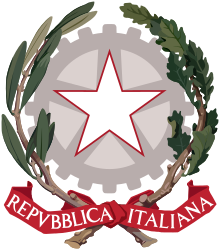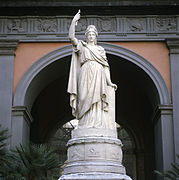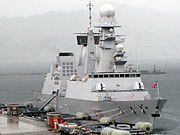
An institutional referendum was held by universal suffrage in the Kingdom of Italy on 2 June 1946, a key event of contemporary Italian history. Until 1946, Italy was a kingdom ruled by the House of Savoy, reigning royal house since the unification of Italy in 1861 and previously rulers of the Kingdom of Sardinia. In 1922, the rise of Benito Mussolini and the creation of the Fascist regime in Italy, which eventually resulted in engaging the country in World War II alongside Nazi Germany, considerably weakened the role of the royal house.
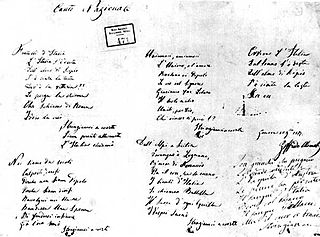
"Il Canto degli Italiani" is a patriotic song written by Goffredo Mameli and set to music by Michele Novaro in 1847, and is the current national anthem of Italy. It is best known among Italians as the "Inno di Mameli", after the author of the lyrics, or "Fratelli d'Italia", from its opening line. The piece, in 4/4 time signature and B-flat major key, has six strophes, and a refrain sung after each. The sixth group of verses, almost never performed, recalls the first strophe's text.

The national flag of Italy, often referred to in Italian as il Tricolore, is a tricolour featuring three equally sized vertical pales of green, white and red, national colours of Italy, with the green at the hoist side, as defined by article 12 of the Constitution of the Italian Republic. The Italian law regulates its use and display, protecting its defense and providing for the crime of insulting it; it also prescribes its teaching in Italian schools together with other national symbols of Italy.

The Victor Emmanuel II National Monument, also known as the Vittoriano or Altare della Patria, is a large national monument built between 1885 and 1935 to honour Victor Emmanuel II, the first king of a unified Italy, in Rome, Italy. It occupies a site between the Piazza Venezia and the Capitoline Hill. The monument was realized by Giuseppe Sacconi.

The emblem of the Italian Republic was formally adopted by the newly formed Italian Republic on 5 May 1948. Although often referred to as a coat of arms, it is an emblem as it was not designed to conform to traditional heraldic rules. The emblem is used extensively by the Italian government.

Associazione Sportiva Dilettanistica Viareggio Calcio, usually referred to simply as Viareggio, is an Italian football club located in Viareggio, Tuscany.

Italia turrita is the national personification or allegory of Italy, in the appearance of a young woman with her head surrounded by a mural crown completed by towers. It is often accompanied by the Stella d'Italia, from which the so-called Italia turrita e stellata, and by other additional attributes, the most common of which is the cornucopia. The allegorical representation with the towers, which draws its origins from ancient Rome, is typical of Italian civic heraldry, so much so that the wall crown is also the symbol of the cities of Italy.

Roberto Stellone is an Italian football manager and former footballer who played as a forward.
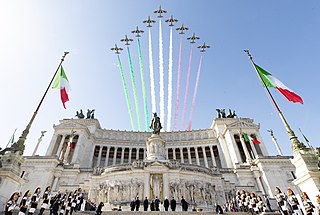
Festa della Repubblica is the Italian National Day and Republic Day, which is celebrated on 2 June each year, with the main celebration taking place in Rome. The Festa della Repubblica is one of the national symbols of Italy.

Giovanni Lista is an Italian art historian and art critic born in Italy on February 13, 1943, at Castiglione del Lago (Perugia) and resides in Paris. He is a specialist in the artistic cultural scene of the 1920s, particularly in Futurism.
The Order of the Star of Italy is an Italian order of chivalry that was founded in 2011. The order was reformed from the Order of the Star of Italian Solidarity by the 11th President of Italy, Giorgio Napolitano. The emphasis of the reformed award was shifted from post-war reconstruction to the preservation and promotion of national prestige abroad, promoting friendly relations and co-operation with other countries and ties with Italy.

The national emblem of Eritrea was adopted on 24 May 1993 on the occasion of Eritrea's declaration of independence from Ethiopia. The emblem mainly depicts a camel surrounded by an olive wreath.

National symbols of Italy are the symbols that uniquely identify Italy reflecting its history and culture. They are used to represent the Nation through emblems, metaphors, personifications, allegories, which are shared by the entire Italian people.

Liberation Day, also known as the Anniversary of Italy's Liberation, Anniversary of the Resistance, or simply 25 April, is a national holiday in Italy that commemorates the victory of the Italian resistance movement against Nazi Germany and the Italian Social Republic, puppet state of the Nazis and rump state of the fascists, during the liberation of Italy and the Italian Civil War during World War II. That is distinct from Republic Day, which takes place on 2 June and commemorates the 1946 Italian institutional referendum.

The national colours of Italy are green, white, and red, collectively known in Italian as il Tricolore. The three Italian national colours appeared for the first time in Genoa on 21 August 1789 on the cockade of Italy shortly after the outbreak of the French Revolution, on 11 October 1796 they were used for the first time in Milan on a military banner, while on 7 January 1797 in Reggio Emilia they appeared for the first time on a flag.
A national coat of arms is a symbol which denotes an independent state in the form of a heraldic achievement. While a national flag is usually used by the population at large and is flown outside and on ships, a national coat of arms is normally considered a symbol of the government or the head of state personally and tends to be used in print, on armorial ware, and as a wall decoration in official buildings. The royal arms of a monarchy, which may be identical to the national arms, are sometimes described as arms of dominion or arms of sovereignty.

National Unity and Armed Forces Day is an Italian national day since 1919 which commemorates the victory in World War I, a war event considered the completion of the process of unification of Italy. It is celebrated every 4 November, which is the anniversary of the armistice of Villa Giusti becoming effective in 1918 declaring Austria-Hungary's surrender.

The Tomb of the Unknown Soldier is a war memorial located in Rome under the statue of the goddess Roma at the Altare della Patria. It is a sacellum dedicated to the Italian soldiers killed and missing during war.

The cockade of Italy is the national ornament of Italy, obtained by folding a green, white and red ribbon into a plissé using the technique called plissage (pleating). It is one of the national symbols of Italy and is composed of the three colours of the Italian flag with the green in the centre, the white immediately outside and the red on the edge. The cockade, a revolutionary symbol, was the protagonist of the uprisings that characterized the Italian unification, being pinned on the jacket or on the hats in its tricolour form by many of the patriots of this period of Italian history. During which, the Italian Peninsula achieved its own national unity, culminating on 17 March 1861 with the proclamation of the Kingdom of Italy. On 14 June 1848, it replaced the azure cockade on the uniforms of some departments of the Royal Sardinian Army, while on 1 January 1948, with the birth of the Italian Republic, it took its place as a national ornament.

The Anniversary of the Unification of Italy is a national day that falls annually on 17 March and celebrates the birth of Italy as a modern nation state, which took place following the proclamation of the Kingdom of Italy on 17 March 1861.

